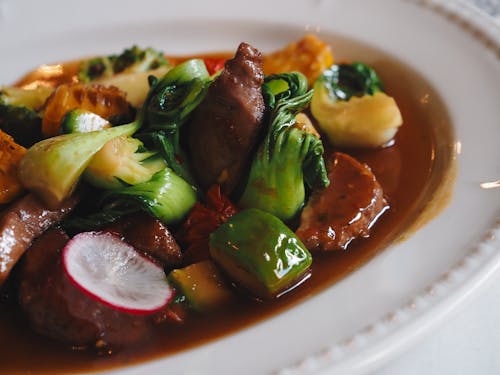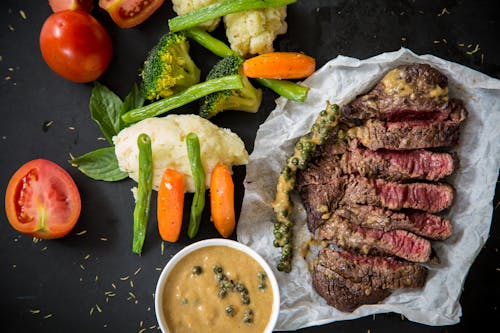Climate change is one of the most urgent global challenges we face today, and its effects are being felt across various aspects of life. One area that often goes unnoticed but is critically impacted is our food system. The rising temperatures, erratic weather patterns, and extreme climate events are affecting everything from crop yields to the availability of fish and livestock. These disruptions are altering what ends up on our plates, changing how food is produced, what food is available, and how much it costs.
Changes in Agricultural Yields and Crop Production
One of the most direct impacts of climate change on food production is its effect on crop yields. Warmer temperatures, changing rainfall patterns, and prolonged droughts are making it harder to grow many staple crops, such as wheat, rice, and corn. These crops are particularly sensitive to temperature fluctuations and need specific growing conditions to thrive. As global temperatures rise, these conditions are becoming less predictable, leading to lower yields and reduced food security.
For example, wheat production in regions like the United States, Canada, and parts of Europe has been severely impacted by extreme heatwaves and droughts. Similarly, corn and soybeans, which are essential ingredients in animal feed and processed foods, are increasingly vulnerable to the effects of climate change. In countries like India and sub-Saharan Africa, where many rely on rice as a staple food, rising temperatures are affecting the crop’s growth cycle, making it more difficult to maintain consistent harvests.

In addition to the direct effects on yield, climate change is also contributing to the spread of pests and diseases that affect crops. Warmer temperatures allow pests such as locusts, aphids, and various plant diseases to thrive in regions where they were previously not a concern. This not only reduces crop yields but also increases the need for pesticides, which can have negative environmental and health consequences.
Changes in Livestock and Fisheries
The effects of climate change extend beyond crops, impacting livestock and fisheries as well. Rising temperatures are affecting the health and productivity of animals raised for food. In hot weather, livestock experience heat stress, which can lead to decreased fertility, lower milk production, and higher mortality rates. Cattle, in particular, are highly susceptible to heat stress, which affects their ability to produce meat and milk at optimal levels.
Water scarcity, a result of climate change, also has a significant impact on livestock production. Water is essential for drinking, irrigation, and maintaining pastures, and when water supplies are disrupted, it can lead to food shortages. In many regions, droughts are reducing the availability of water for livestock, leading to reduced animal growth rates and, in some cases, increased mortality.
Fisheries are facing their own set of challenges due to climate change. Rising ocean temperatures, ocean acidification, and changing water currents are all affecting fish populations. Many fish species are migrating to cooler waters, which affects local fisheries that rely on specific fish stocks. For example, the fishing industry in Alaska has been significantly impacted by warming waters, which are disrupting the migration patterns of key species like salmon and cod. Additionally, warmer waters can lead to the growth of harmful algal blooms, which can make fish toxic to consume and further threaten the livelihood of fisheries.
Shifts in Food Availability and Prices
The combined effect of these changes in agriculture, livestock, and fisheries is that certain foods are becoming less available and more expensive. For instance, staple crops like wheat, rice, and corn are experiencing higher price volatility due to fluctuating yields. As a result, food prices are rising globally, affecting both consumers and food producers.
For example, extreme droughts in the United States and other major grain-producing countries have caused wheat and corn prices to spike. These price increases affect not only the cost of these grains but also the cost of products that rely on them, such as bread, pasta, and processed foods. The rising costs of animal feed, driven by high grain prices, are also contributing to the increase in meat and dairy prices. Consumers are already feeling the effects, with grocery bills rising across the globe.
At the same time, there is a shift in the types of foods that are available. As traditional crops struggle to adapt to the changing climate, we are seeing a rise in the production and consumption of alternative crops that are more resilient to extreme weather. For example, sorghum, millet, and quinoa are being promoted as drought-resistant alternatives to rice and wheat. These grains, along with other climate-resilient crops such as sweet potatoes and legumes, may become more common in the coming decades as part of efforts to diversify food sources and protect against climate variability.

Impacts on Nutritional Value and Food Safety
Climate change is not only altering the availability of food but also its nutritional value. Studies have shown that rising carbon dioxide levels can reduce the nutritional content of crops, including key vitamins and minerals like zinc, iron, and protein. For example, wheat and rice, two of the world’s most consumed grains, are particularly affected by increased carbon dioxide levels, which reduce their concentrations of essential nutrients.
The reduced nutritional quality of crops could have serious implications for public health, especially in developing countries where staple crops are the primary source of nutrition. As climate change makes it harder to grow nutrient-rich foods, it could lead to increased rates of malnutrition, particularly among vulnerable populations.
Furthermore, climate change can increase the risk of foodborne illnesses. Warmer temperatures and unpredictable weather patterns create more favorable conditions for bacteria, fungi, and other pathogens to thrive. For example, warmer waters can lead to increased levels of harmful bacteria in seafood, while warmer air temperatures can increase the prevalence of foodborne pathogens like Salmonella and E. coli in meat and produce. These pathogens can lead to outbreaks of foodborne illness, further complicating food safety.
Adapting to a Changing Food Landscape
As the effects of climate change continue to unfold, there is a growing need to adapt food systems to ensure food security and sustainability. Solutions range from adopting climate-resilient farming practices to investing in alternative food sources. For example, agroecological farming techniques that focus on soil health, crop diversity, and water management can help farmers adapt to changing climates and protect their yields.
Sustainable agriculture practices, such as precision farming and vertical farming, are also gaining traction. These methods use technology and innovative techniques to optimize resource use, reduce waste, and minimize environmental impacts. By improving efficiency and reducing dependence on chemical fertilizers and pesticides, these practices can help mitigate the negative effects of climate change on food production.
At the same time, there is an increasing emphasis on shifting diets to more sustainable and resilient food sources. This includes embracing plant-based diets, which have a lower environmental impact compared to animal-based diets, as well as diversifying the types of crops we eat to include more climate-resilient options. Increasing the availability of sustainable food sources like algae, seaweed, and edible insects could also help alleviate some of the pressure on traditional food systems.

Conclusion
Climate change is already affecting the food that ends up on our plates, from crop yields and livestock health to the availability of fish and the overall cost of food. As temperatures rise and weather patterns become more unpredictable, the challenges facing food production are intensifying. However, there is hope. By adopting sustainable practices, investing in new food technologies, and shifting towards more climate-resilient food systems, we can ensure that future generations will continue to have access to nutritious and affordable food. Adaptation and innovation are key to overcoming the challenges of climate change and building a food system that can thrive in a warming world.





